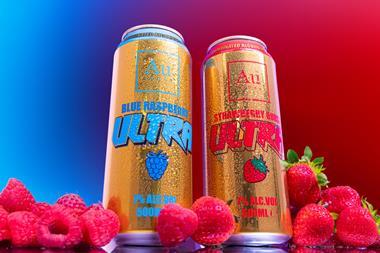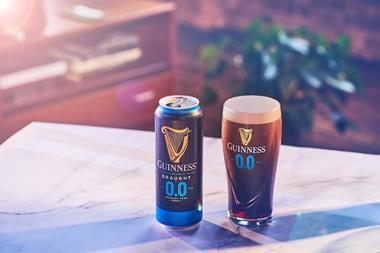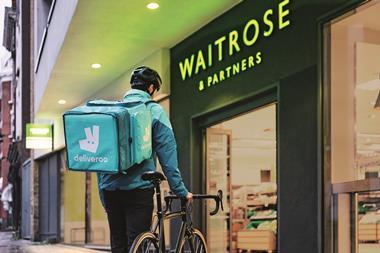US supermarkets are being urged to employ new weapons in their war for a bigger share of the food dollar. Helen Gregory reports from Chicago
We may get inspiration from the US and it's sometimes months, even years, before innovations cross the Atlantic, but it isn't always advisable to follow its lead.
With the eating out market exploding, US retailers are galvanising themselves to retaliate against the foodservice sector. Sales growth in the "food at home" sector was down from 5.7% in 1999 to 4.2% last year, while like-for-like sales growth dropped to 1.8% from 2.7% the lowest rate since 1992, and retailers at the Food Marketing Institute conference in Chicago last week were urged to promote cooking as fun in order to win back share of the American stomach.
FMI senior vice president Michael Sansolo told delegates: "The food at home' market keeps declining. In tough times, people used to respond by eating more at home but in the early 1990s consumers did not return the food dollar to supermarkets.
"We suffered a real decline in sales last year. There's so much pressure on companies and more mergers and acquisitions as a market we're contracting. The stronger companies are surviving and are finding ways of using technology to gain efficiencies and to push profitability," he said.
A staggering 79% of American consumers eat out every week and Sansolo admits that the sector will probably never get all the "food dollar" back, especially from younger shoppers. "We need to get the message across to consumers that cooking at home is fun. If we don't work on them they will disintegrate on us."
CEO of the Neighbourhood Marketing Institute, Tom Feltenstein, urged retailers to spend up to 70% on marketing inside their own four walls in their fight against the foodservice industry.
Feltenstein said that stores were the most potent marketing weapons that retailers had. Advertising in the mass media "is dead", he proclaimed. "We keep shouting over people's heads, when instead, we should only market to the people within a 10 minute drive of our stores."
He emphasised the importance of focusing on employees, whom he described as "internal customers", advocating that 2% of gross revenue should be allocated to training.
Staff should be jolly if they spoke to customers on the phone and could even start the selling process when they picked it up "Hello, I'm John and we have 50 cent ground beef today"
"Retailers don't have fun any more," he protested. "And you need to reward your shoppers and give them vouchers for free groceries. This crap works!"
Feltenstein said stores should find out where every shopper lived and plot their addresses on a map, along with places of worship and hotels. "People running for public office go out and try to make their constituents happy so should you."
Because cutting prices at the bottom line was so hard, growth should be achieved above the line instead, so retailers had to round up new business, increase the frequency of visits and basket size.
"Service is mechanical now, it's not personal, you need to offer great hospitality instead, to connect with people.
He urged retailers to "throw your arms around shoppers" find out their name and do not take them for granted and told them to create a hospitality action plan.
His suggestions for improving instore marketing included:
- give every employee who has worked for longer than 90 days a personal business card.
- allow staff to give away free goods to make them feel important
- find out who has moved into the area and target them with promotions
- put up posters of shopper testimonials each month
- send a new employee home on their first day with a meal for their family
- start an employee of the moment' scheme for instant rewards
- have a get out of work free' card scheme usable seven days in advance
- pay people if they're always well, not only for going sick
- give cashiers Velcro dart boards so that customers who throw a bullseye get their shopping free
- picket the store with placards stating "this store is too good"
- merchandise in the toilets
Inside US stores, the food mix is changing to represent consumers' growing obsession with all things healthy.
The market has seen a growth in herbal supplements, non-dairy supplements and soy-based products; annual sales of soy products are $1.75bn and expected to rise to about $3.7bn by next year. Sales of soymilk in particular jumped 47% last year, while meal replacement bars are also booming the market grew 76% last year and sales are soon expected to exceed £2bn.
Three of the top 15 selling categories in the US were snacks, and industry figures valued the market at more than $26bn. An average store carried about 40 more snack SKUs last year than in 1999 and consumers are reportedly increasingly looking for "better for you" snacks.
Fears about health and food safety have led to irradiation becoming legal in the US. Andrew Hynick, director of marketing at Sunbeam, a company that electronically pasteurises food, said the system is condoned by many manufacturers and shoppers. However, currently only 1% of food is irradiated in the US.
"Every week in the US, 100 people die from foodborne illness and new bacteria wreaking havoc on the food supply," he said. "And although the food chain is generally safer, E.coli wasn't around 25 years ago and our technology helps reduce that."
Hynick said his research had shown that 20% of consumers are willing to pay a premium for food that has been pasteurised and the firm could now work on meat, eggs, fruit, vegetables and petfood, and hoped to get approval for processed food.
But despite the growing interest in healthy food, launching a new product Stateside is not easy. Valerie Skala, vice-president of analytic product management and development at Information Resources Inc, warned that between 20,000 and 30,000 new products are launched in the US fmcg sector every year, including 1,000 new brands.
The top new items in the US last year were Pepsi One and Swiffer cleaning cloths and, although these were multi-million dollar earners, 80% of all new brands had first year sales of less than $10m.
Skala said the key attributes of the top performers were that they were new to the world and offered performance and convenience.
She added that the major consumer themes driving product innovation were that people were living longer and staying active longer and wanted low calorie, energy giving and vitamin enhanced foods to support this. They had less time and wanted portable products to take steps out of their cooking regime. They were also stressed out and uncertain about their future and wanted food that soothed and indulged them which was also natural and organic. They liked their individuality catered for and wanted products that could be customised "just for me".
According to research, more than half of all new products fail within two years: 30% fail because they do not articulate their positioning; another 30% fail because they don't live up to consumer expectations; 30% failed to raise sufficient awareness through their ad campaigns; and 10% failed through inadequate distribution.
The average successful new brand had $10m spent on promotion in the first year, while the first product of its type on the market usually does best, the second "me-too" product gains 70% of sales and the third gains about 55%.
{{FEATURES }}
Close menu
- Home
- Retail & Wholesale
-
Products & Suppliers
- Back to parent navigation item
- Products & Suppliers
-
Product Categories:
- Back to parent navigation item
- Product Categories:
- Alcoholic drinks
- Bakery
- Cereals & breakfast
- Cheese
- Chicken & poultry
- Chocolate
- Confectionery
- Crisps, nuts & snacks
- Dairy
- Fish
- Fresh produce
- Frozen
- Household
- Meat
- Own Label
- Sauces & condiments
- Seasonal
- Soft drinks
- Vaping
- Vegan & plant-based
- World foods
- Suppliers
- People
- Reports & Data
-
Topics A-Z
- Back to parent navigation item
- Topics A-Z
-
Popular topics:
- Back to parent navigation item
- Popular topics:
- Cost of living crisis
- Crime
- Deposit Return Schemes
- Finance
- Government & Regulation
- Health
- Inflation
- Loyalty
- Marketing
- Mergers & Acquisitions
- New Product Development
- Sourcing
- Supply chain
- Sustainability & environment
- Technology
- Ultra Processed Foods
- Vaping
- A-Z all topics
- Content by type:
- Events
- Ask iA (beta)
- Subscribe now
Sign in to comment on this article
Not logged in before? Register for FREE guest access today.
You will be able to:
- Read more stories
- Receive daily newsletters
- Comment on stories
Advert


















No comments yet